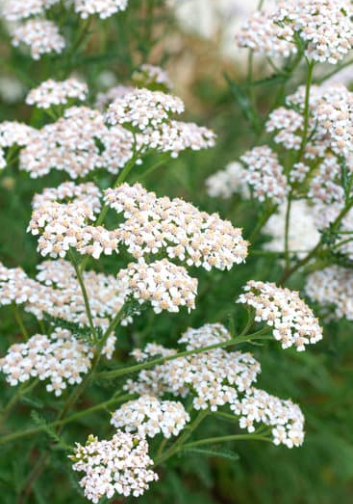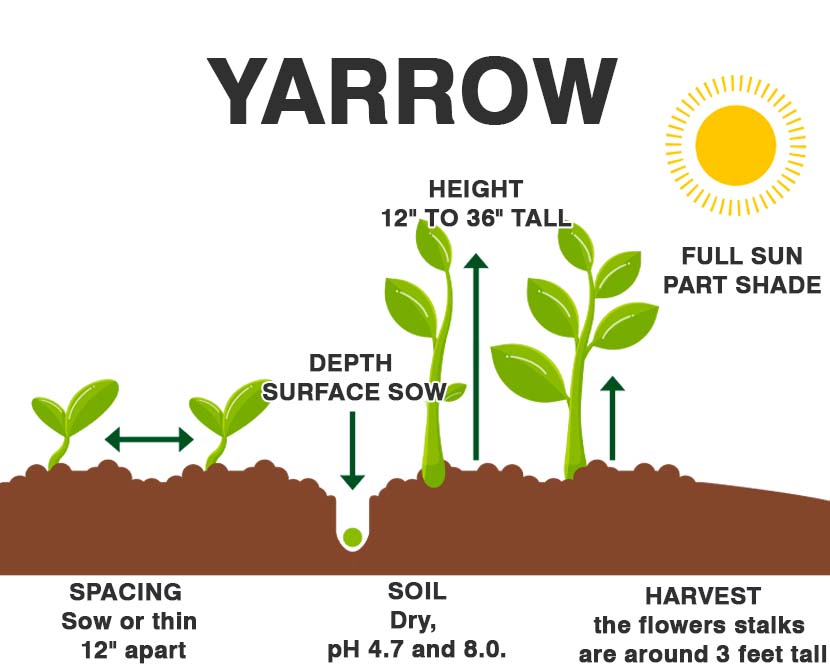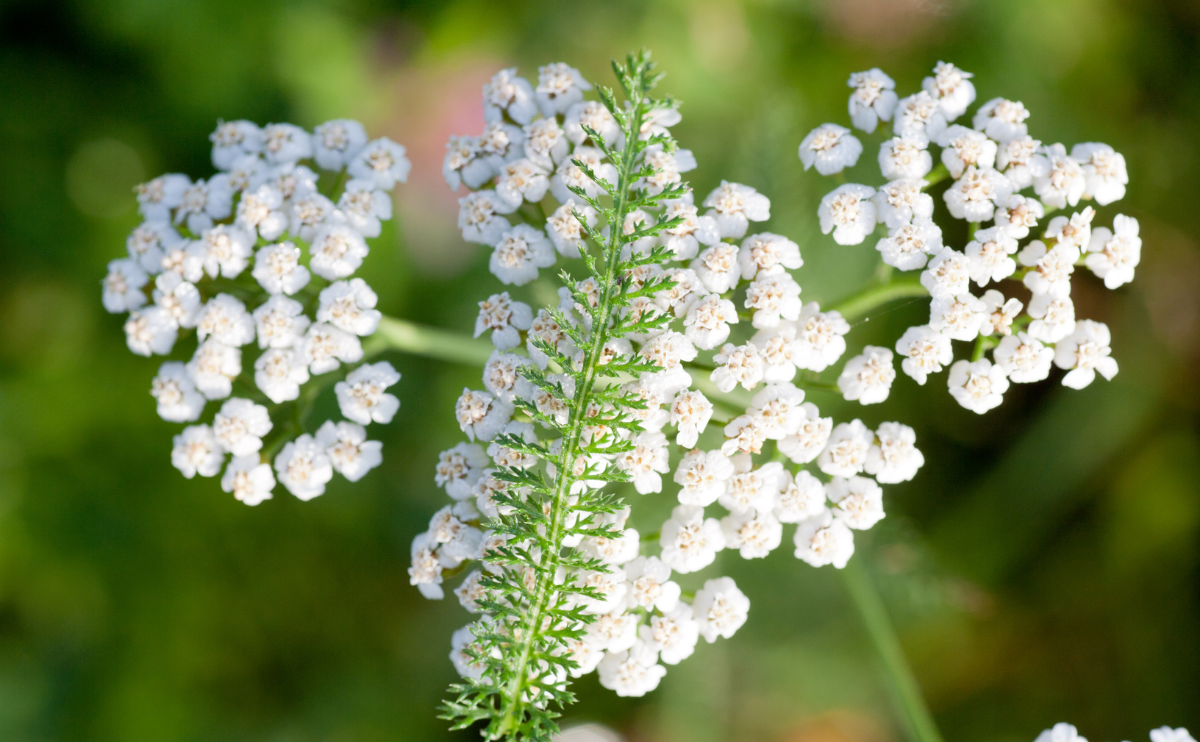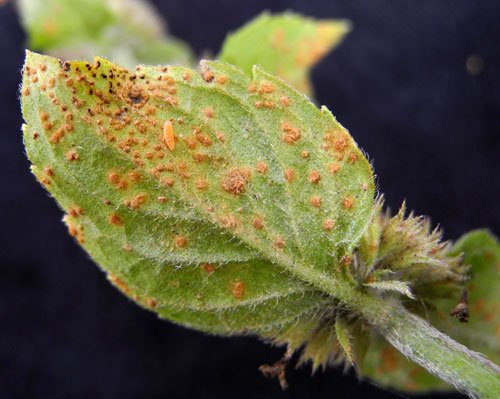Common yarrow (Achillea millefolium) is a perennial flowering plant that goes by many names, like gordaldo, poor man’s pepper, and thousand leaf. In the southwestern U.S., you’ll hear it referred to as a plumajillo, Spanish for “little feather” due to the feathery shape and lacy texture of the plant’s aromatic leaves. Yarrow can grow to reach more than 3 feet tall during the course of a growing season, and it bears an umbrella-like canopy of clustered mini blooms on long, slender stems. Plant this herbaceous perennial in the spring, and come summer, you’ll be graced with little white flowers.
Common yarrow’s native propagation originated in the temperate regions of Asia and Europe, and it was introduced to North America during the colonial era. It is commonly seen growing across the United States in dry, disturbed soil, and while its beauty is delicate, the plant is also considered an aggressive weed. Common yarrow can be toxic to dogs, cats, and horses, yet poisoning is rare, as the tannins in the plant give it a bitter taste that deters animals from overconsumption.

| Common Name | Yarrow, thousand-leaf, thousand-seal |
| Botanical Name | Achillea millefolium |
| Family | Asteraceae |
| Plant Type | Perennial |
| Mature Size | 2 to 3 ft. tall, 2 to 3 ft. wide |
| Sun Exposure | Full |
| Soil Type | Sandy, loamy, clay, well-drained |
| Soil pH | Neutral |
| Bloom Time | Summer, fall |
| Flower Color | White, yellow, pink, red, purple, orange |
| Hardiness Zones | 3-9 (USDA) |
| Native Area | Asia, Europe, North America |
| Toxicity | Toxic to cats, dogs, and horses |

When to Plant?
This will be determined by your planting zone. There is a final frost date for each area. As a result, you can plan your gardening activities around this date. Check our Frost Dates Across North America: First & Last Frost Dates Chart. However, the date will not be the same for every plant.
How to Plant
Start seeds indoors about six to eight weeks before your last frost date. Sow the seeds in moist, normal potting soil. The seeds should just barely be covered by the potting soil. Place the pot with the yarrow seeds in a sunny and warm location.
The seeds should germinate in 14 to 21 days, depending on the conditions. You can speed up the germination by covering the top of the pot with plastic wrap to keep in moisture and heat. Remove the plastic wrap once the seeds have sprouted. Regardless of whether your yarrow plants are grown from seed or bought as full plants, you will want to plant them in full sun.

They thrive in a wide variety of soils but do best in well drained soil. Yarrow plant will even grow in very poor dry soils with low fertility. Some caution should be taken when growing yarrow, as in the right conditions, it can become invasive and will then be in need of control.
Transplant (recommended): Sow 8-10 weeks before last frost. Do not cover seed as light is required for germination. Bottom water or mist lightly to avoid covering the seed with displaced soil. Transplant to cell packs or 2-4″ containers when the first true leaves appear, approximately 3 weeks after sowing. Harden off and transplant outside after the last frost. Direct seed: Sow seed in late spring, after late frost, early summer, or fall. Thin to stand 12-24″ apart. Support may be necessary.
How to Cultivate
Soil – it will not tolerate soil that’s constantly wet.
Sun – Full sun to part shade
Spacing – 12″
Water – Moist to dry (it’s adaptable)
Let the soil dry out completely before watering.
Fertilizer – This plant has no special fertilizing needs
How to Harvest
If you’re growing yarrow or stumble onto a wild patch of the herb, you should learn how to gather it. It’s a good idea to wait until the yarrow is in full bloom so it has more of its spicy fragrance. Use pruning shears to cut the stalk a few inches above the soil. Then you can use the stalk, leaves, and flowers that you harvested. Many herbalists use yarrow for its anti-inflammatory and pain relieving properties.
Hydroponics
Germination: Yarrow seeds can be germinated in a seedling tray filled with hydroponic growing media, such as rockwool cubes or coco coir. The seeds should be planted about 1/4 inch deep and kept moist until they sprout, which typically takes 1-2 weeks.
pH range: The pH range for hydroponic yarrow should be between 6.0-7.0. Maintaining the correct pH level is important for the plants to absorb the necessary nutrients.
EC: The electrical conductivity (EC) level should be maintained at around 0.6-1.6 mS/cm for hydroponic yarrow. This helps to ensure that the plants receive the right amount of nutrients.
PPM: The parts per million (PPM) for hydroponic yarrow should be around 400-1000 ppm. This measures the concentration of nutrients in the water solution.
Humidity: Yarrow prefers a moderate to low humidity level of around 50-60%. Use a hygrometer to monitor the humidity level in your growing area and adjust as necessary using a dehumidifier or humidifier.
Light hours: Yarrow requires at least 6-8 hours of light per day to grow properly. Ideally, provide 12-16 hours of light per day using a grow light with a spectrum suitable for vegetative growth.
Air temperature: The air temperature should be maintained at around 18-24°C (64-75°F) during the day and around 15-18°C (59-64°F) at night for yarrow to grow well.
Water temperature: The water temperature in your hydroponic system should be maintained between 60-75°F (15-24°C). Use a water heater or chiller to adjust the water temperature as needed.
By following these guidelines, you should be able to successfully grow yarrow hydroponically. Good luck with your growing!



